A dragon has taken up residence in the mountains near the town of Havinia. Drawn to the region by this threat, the characters have limited time to prepare for battle while hunting the dragon. This is the premise of the cooperative RPGesque board game Dorasure.

I had been interested in Dorasure since I first saw it, but only recently picked it up at the Fall Tokyo Game Market. Published by the miniature shop Giant Hobby, Dorasure is cooperative board game with simple mechanics that is difficult to beat. The difficulty works in its favor, though, as does the short play time. There are multiple supplements for it, but we’ll just be looking at the base game. Just by chance a local board game cafe had a Dorasure event, so I managed some play time as well. My thoughts based come at the end.
Contents

The game board folds in half
and is sturdy. There are five characters, each with a small character sheet and unpainted metal miniature. There is a twelve page manual, note about miniature design changes, and reference sheet. 13 dice, 13 tiles, 9 damage tokens, 5 completion markers, and 15 glass markers round out the box that costs ¥3,973 retail. It seems apropos that Giant Hobby, a miniatures game shop, would produce a game with miniatures. The components are all sturdy.
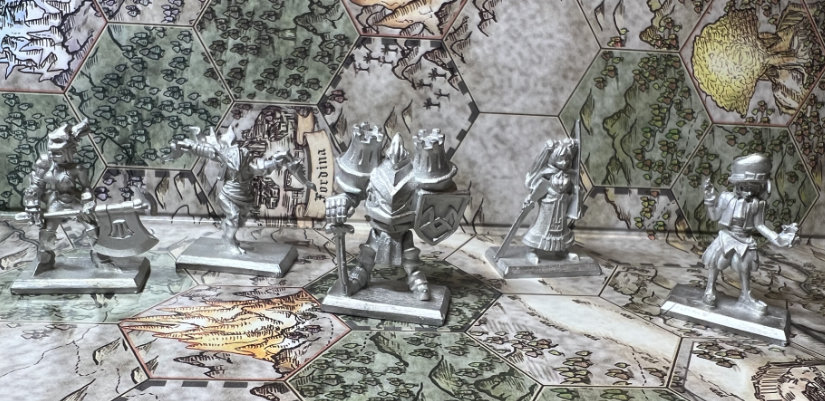
Mechanics
The base game is for two to five players, but expansions can take that to as low as one or as many as eleven. Play time is estimated at thirty minutes, which tracks with my experience. This is a completely cooperative game, and there are mechanical benefits to working together.
Characters
True to RPG form, each player chooses a character: Gladiator, Hunter, Paladin, Prince, or Ninja. Each has different stats, unique weapon, level ups, and resources.
Regardless of the type of resource, resources may be spent to boost a roll or decrease incoming damage. It’s how the resources are gained that differs. The weakly Prince regains their subordinates (部下) each turn, while the Ninja gains Ninjutsu when moving in a forest. In contrast, the Gladiator has no resources, making up for it in life and battle.
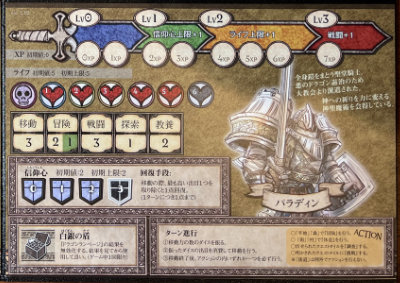
The character stats are Move (移動), Adventure (冒険), Combat (戦闘), Exploration (探索), and Education (教養). Interestingly, the Adventure stat has two values, one for flat land and one for forests. Some characters excel at one terrain or the other. They also have Life and XP pools. Character stats can increase as they gain levels using XP from adventuring.
Rolling
The majority of die mechanics are built around the Peak Roll. Using dice pool system, a number of dice are rolled and dice with a result of 4 our more count as successes. Rolling a six is a critical and adds another die to the pool, while a one is fumble, decreasing the total by one.
Lay of the Land
 The game board is hex-based, depicting a countryside with a major town, two villages, and five mountains. Each mountain contains a quest and reward for completing the quest, both of which are randomized at the start of play. The type of hex determines movement cost, which we’ll look at in the Adventure phase below.
The game board is hex-based, depicting a countryside with a major town, two villages, and five mountains. Each mountain contains a quest and reward for completing the quest, both of which are randomized at the start of play. The type of hex determines movement cost, which we’ll look at in the Adventure phase below.A Dragon’s Patience
The dragon is not idly waiting for the adventurers. Rolling a six during the movement roll increases the Dragon Gauge. Every few steps on the gauge triggers a Dragon Action, where the dragon retaliates. When a Dragon Action is triggered, a d6 is rolled and its result referenced against the Dragon Action chart. Many of these involve randomly determining which characters take damage, but some will actually change the map by destroying the village of Belk. When the Dragon Gauge is maxed out or all five rewards are won, the Adventure phase ends and the Decisive Battle begins.
Phases
The game is played in two phases: Adventure and Decisive Battle.
Adventure Phase
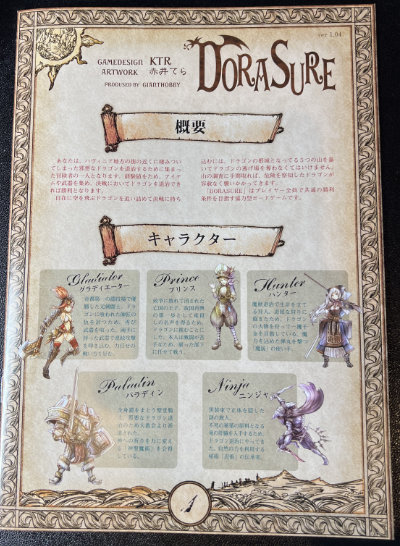
During the Adventure phase, characters travel the map looking for adventure to level up and explore the peaks of surrounding mountains, searching for the dragon. Each turn begins with players rolling their movement stat in d6 dice. Sixes increase the Dragon Gauge. The type of terrain determines the cost of movement. Plains are easier than forests to traverse, and roads even more so. Movement dice of at least that value may be used to move one hex. While movement is optional, the movement roll must be made since it can increase the Dragon Gauge. After movement, one action is taken: Adventure if in a plains or forest; Investigate if next to a mountain with face down quest; or challenge if next to a face up quest token. Resting at a town is also possible, and doing so heals two life.
Choosing the Adventure action calls for a Peak Roll rolling a number of dice equal to the Adventure stat. The resulting total is compared to the Adventure chart. Results range from damage only, XP and damage, and XP only.
Exploring a mountain reveals the quest card on it. Once revealed, the quest may be challenged on a subsequent turn. Challenging involves a Peak Roll using the attribute specified on the quest card. Succeeding brings the quest results to all quest participants, and the reward card to all characters. Failing with some successes can reduce the difficulty on subsequent checks. Characters may also work together, both making Peak Rolls and combining their results, but also suffering the consequences together if they fail. Successfully completing a quest results in 2XP for performed by one character, or 1XP per character if performed as a group.
Characters level up as they gain XP. The effects of leveling vary per-character, but generally increase stats, health, or max resources.
There are multiple types of treasure, each helping all players. Some help directly by unlocking abilities, increasing the Combat rating, or giving XP, while collecting two of the dragon hideout treasures deals damage to the dragon ignoring dragon rampage.
Should an adventurer fall during the Adventure phase, the game ends with the players losing. However, there’s a miraculous chance that the dead character is revived and the game does not end if any of the players rolls a six on a d6.
Decisive Battle
Once preparations are done (or the dragon properly angered!) the Decisive Battle begins. Characters are moved to a small square on the board and the battle begins. If the battle began due to the Dragon Gauge filling, two Dragon Actions happen immediately. If begun by acquiring all five rewards, battle begins without the attacks.
Beginning with the character that initiated the Decisive Battle, players take turns making Peak Rolls with the Battle stat. Dice results are compared to the Decisive Battle table and the results applied. In the worst case, a character is swallowed whole and instantly dies. Other results deal a mix of damage while receiving damage, while higher results take little to no damage. There’s also a chain attack, which allows other characters to add join in and modify the total, at the risk of making it worse. Should the chain attack end with the same result, the characters take damage.
Dragon health is on a track with Dragon Rampages occurring at certain points. These are unavoidable, and are similar to Dragon Actions in that a d6 is rolled and compared to the Dragon Rampage chart. Most results result in damage, but a result of one means nothing happens. The last point of damage must be applied on its own turn. In other words, if the dragon has two health left and two damage is dealt, only one damage is applied (and a Rampage ensues). The game is won if on a subsequent turn another point of damage is applied. In the case of all heroes and the dragon dying on the same turn, the heroes are posthumously victorious.
Impressions
The rules are easy to understand and a lot of variety provided by the different characters while still being consistent and easy to understand. The prince having low stats, but lots of resources to spend, was an interesting surprise. There’s a lot of randomness with the dice rolls, but using dice pools limit it somewhat. From what I’ve read, it’s a difficult to beat game.
I only found out about it while researching for this post, but there was a Kickstarter for English an version of the game that was unfortunately cancelled. There’s additional game details and images there, including many of the expansion characters.
Language
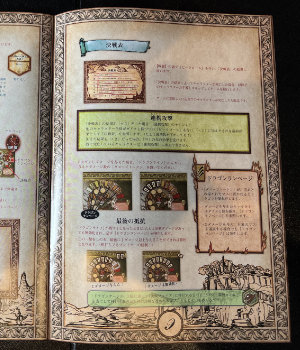
The manual is twelve pages of sparse text with multiple diagrams and examples, making it a quick read. The language itself is clear, though I did have to re-read a couple of rules to make sure I fully understood them.
There is text on the character sheets, the tables, and the quest tokens, but a translation could be referenced without too much issue. Some of the expansion character sheets can get pretty wordy, but the core characters are streamlined.
Flavor Text
都市第一の戦技場で優勝した元剣闘士。ドラゴンに食われた師匠の仇を討つため、再び武器を取った。
A former gladiator champion of the capital’s foremost arena. She has again taken up her blade to avenge her mentor who was eaten by the dragon.
Rules Text
ドラゴンにダメージを与えた場合、「ドラゴンライフ」の左から、与えたダメージ数のダメージトークンを置いてください。
When you damage the dragon, place a number of damage tokens corresponding to damage dealt from the left of “Dragon Life”.
Play Experience
By chance a nearby game cafe had a Dorasure event that I was able to participate in. My first game was two players using the base set, and we somehow managed to emerge victorious on the first try. Having saved one region, we decided to next try an expansion map…which we spent the rest of the night trying to clear. A couple of other players joined us on our quest, and we finally defeated two dragons.
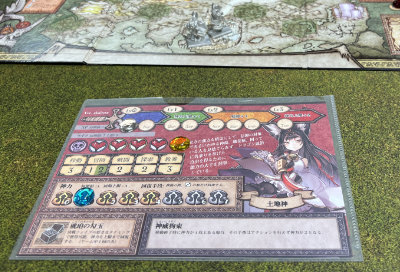
Thanks for them having all the expansions, I was able to try a variety of characters. I was really surprised by how differently each character played. The expansion characters tended to add interesting complexity in both their abilities and how they managed resources. I really enjoyed how the character designs were realized in the mechanics. With seemingly small changes, the pacing and character strategy could change drastically.
One character I particularly enjoyed was the Land God. She has the potential to unlock eight resources, but if she has four or more after moving, she cannot take an action and goes down to two resources. Rolling a three during movement increases resources by one. However, once per game during the Decisive Battle, she can regain all resources. In contrast to this is the Hunter, which regains all resources by resting in a town. Another expansion character gains resources when they move more than 3 hexes in a turn. One of the more wild characters was super specialized for the Decisive Battle and able to burst with up to twelve dice, but weak during the exploration phase.
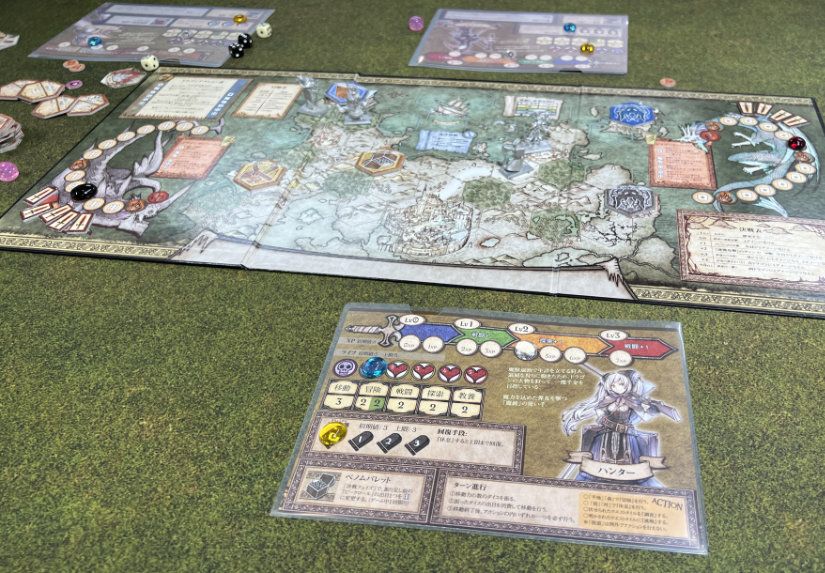
I was by far the least experienced player, but quickly fell into a rhythm. The game played very smoothly once I got used to it, and it was fun to rolls lots of dice. The dice can be very fickle and randomness often led our best plans astray, but when luck was with us, the entire was lit up with excitement.
Dorasure captures and condenses the JRPG experience into an enjoyable thirty minute game. It’s short enough that the difficulty makes retrying enjoyable, and I found myself continuing to think about the game the next day.
| Dorasure | |
|---|---|
| Time | 30 minutes |
| Players | 2-5 |
| Ages | 10 |
| Official Site | Giant Hobby store |
| Board Game Geek |

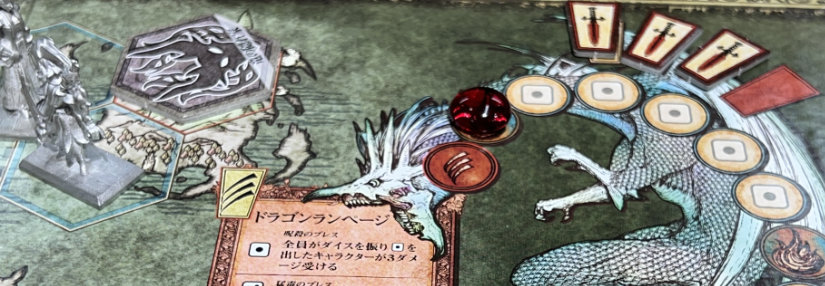
It seems like a great fantasy game! I love that it has original miniatures. I’ve always liked when board games do that instead of the generic coloured pawn piece.